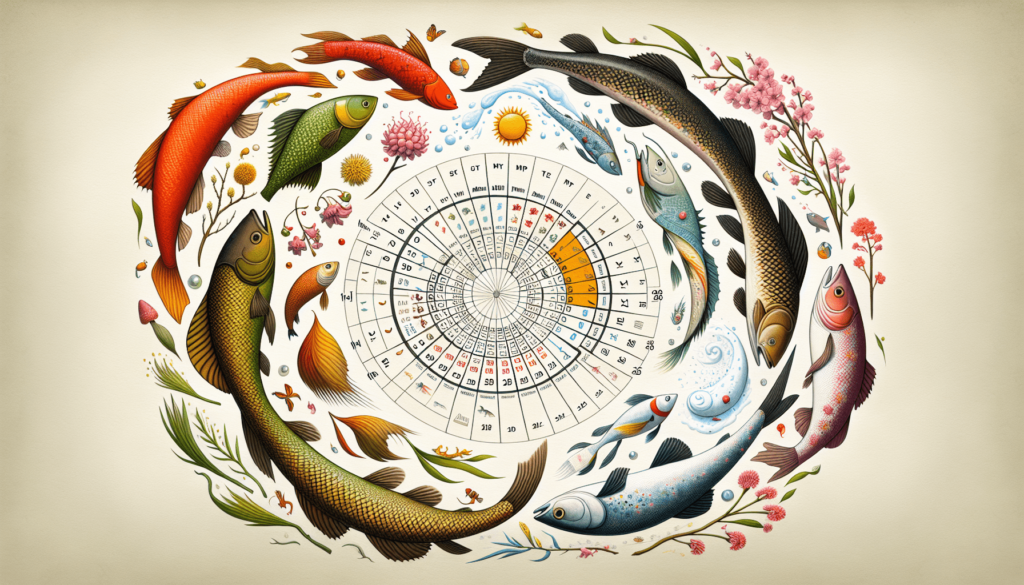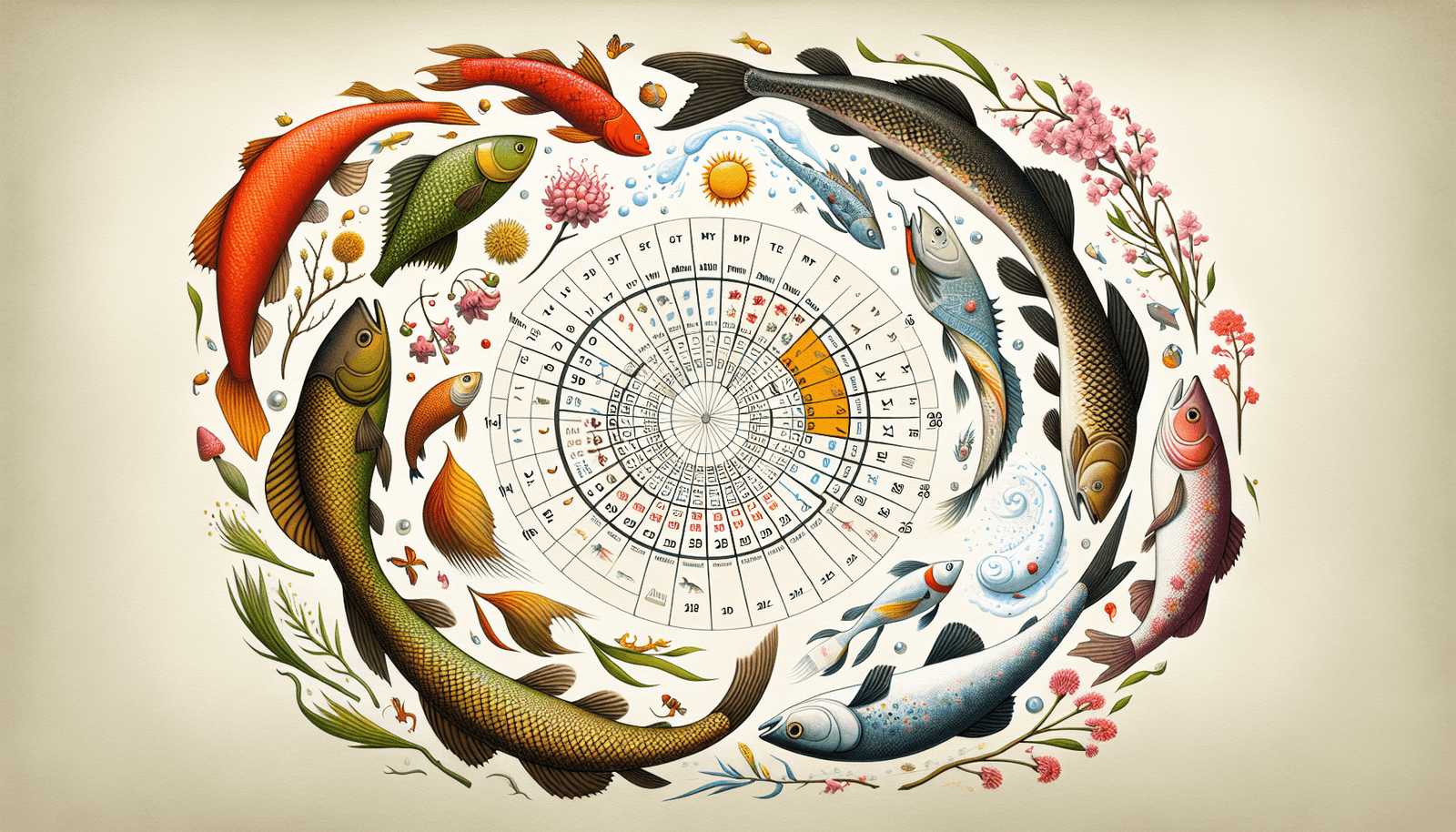Imagine having the inside scoop on the best times to cast your line for each type of fish, turning your fishing trips into a series of unforgettable adventures. That’s exactly what you’ll find in the “Seasonal Fishing Guide: What to Fish and When”. This guide is your ultimate companion, ensuring you’re in the right place at the right time to catch the fish of your dreams. From the icy grips of winter to the warm embrace of summer, it maps out what species are biting during each season, so your fishing excursions are as fruitful as they are enjoyable.
Fishing is not just a pastime; it’s an art that involves understanding the environment and the behavior of fish throughout the seasons. Knowing when and where to fish can dramatically increase your chances of a successful catch. Let’s dive into how seasonal changes affect fish and how you can utilize this knowledge to your advantage.
The influence of water temperature on fish activity
Water temperature plays a crucial role in determining fish activity levels. Fish are cold-blooded creatures, meaning their body temperature and metabolism are directly influenced by their environment. Generally, fish are more active in warmer temperatures as their metabolism increases, leading to more feeding. However, too warm can lead to decreased oxygen levels in water, making fish lethargic. Understanding these nuances can help you predict fish behavior.
How seasons affect fish migration and spawning
Seasonal changes drive fish migration and spawning activities. In spring, many fish species migrate to spawn, making it a prime fishing season. Similarly, fall triggers a feeding frenzy as fish bulk up for the winter, providing another excellent fishing opportunity. Recognizing these patterns allows you to anticipate where fish might be gathering during different times of the year.
Recognizing the optimal fishing seasons for different species
Each fish species has its preferred season for feeding and spawning, making certain times of the year better for targeting specific fish. For example, bass are more active in spring and fall, while trout prefer colder water, making them a prime winter target. Learning these preferences will guide you in choosing the best season to fish for your desired species.
Spring Fishing Guide
Spring breathes new life into the waters, making it a fantastic season for fishing. As the water warms, fish become more active, providing ample opportunities for anglers.
Key fish species to target in spring
Bass, trout, and crappies are among the top species to target in spring. These fish are emerging from their winter lethargy and are on the lookout for food, making them more susceptible to bait and lures.
Recommended lures and baits for spring fishing
Soft plastics, spinnerbaits, and crankbaits are excellent choices in lures for spring fishing. For baits, worms, minnows, and insects are highly effective as fish are in search of hearty meals to replenish their energy.
Prime fishing locations during the spring season
Look for shallow waters where fish might be spawning or searching for food. Lakes, ponds, and slow-moving rivers are ideal locations as the warmer, shallower waters are more conducive to fish activity during spring.

Summer Fishing Guide
The warmth of summer maintains high fish activity, though the heat can also pose challenges. Early mornings and late evenings are the best times to fish to avoid the midday heat and lethargy in fish.
Best fish to catch in summer months
Bass, catfish, and tarpon are great targets during the summer. These species tolerate the warmer temperatures well and remain active throughout the season.
Effective summer fishing techniques and equipment
Topwater fishing can be remarkably effective in summer, especially during the cooler hours of the day. Lightweight lines and gear are recommended due to the fish being more wary in the clear, warm water.
Ideal summer fishing spots and what you’ll find
Areas with cover, such as docks, lily pads, and submerged logs, are hotspots during summer. These locations offer fish shelter from the heat and predators, making them excellent fishing spots.
Fall Fishing Guide
Autumn signals a change in fish behavior as they prepare for the colder months ahead. This season is characterized by aggressive feeding, making it one of the best times for fishing.
Top fish species for autumn angling
Bass, pike, and walleye are particularly active during fall as they bulk up for winter. Their increased appetite makes them more likely to bite.
Fall bait and lure preferences
Crankbaits, jigs, and soft plastics are effective in fall due to their ability to mimic the fish’s natural prey. Live baits such as worms and minnows are also highly successful.
Spotting productive fall fishing locations
Look for areas where fish are likely to feed, such as creek mouths and ledges. Water temperature drops will drive fish to warmer areas, so keep an eye on temperature transitions for hot spots.

Winter Fishing Guide
Winter fishing can be challenging but also rewarding with the right techniques and locations. Ice fishing dominates in areas with harsh winters, while open water fishing prevails in milder climates.
Winter fishing: Ice fishing vs. open water
Ice fishing is a unique experience, focusing on species like pike, trout, and perch. Open water fishing in winter requires patience and skill, targeting species like trout and bass in deeper waters.
Fish species active during winter
Trout, pike, and perch are more active during the cold months, making them prime targets for winter fishing.
Choosing the right gear for winter fishing conditions
For ice fishing, augers, ice shelters, and specialized ice fishing rods are essential. For open water, focus on heavier lines and baits that can reach deeper, slower-moving fish.
Freshwater Fishing Guide
Freshwater fishing offers a variety of species and experiences throughout the year. Understanding the habitat and behavior of freshwater fish can enhance your fishing adventures.
Popular freshwater species by season
Spring and fall are excellent for bass and crappie, while summer is ideal for catfish and bass. Winter brings opportunities for trout and pike, especially in areas suited for ice fishing.
Freshwater habitats: lakes, rivers, and streams
Each freshwater habitat presents unique fishing opportunities. Lakes are great for bass and pike, rivers for trout and salmon, and streams for smallmouth bass and trout. Each requires different strategies and techniques.
Seasonal freshwater fishing strategies
Adapt your strategies to the season. Spring and fall call for aggressive tactics, summer requires finesse and patience, and winter demands perseverance and adaptation to the colder conditions.
Saltwater Fishing Guide
Saltwater fishing brings its own set of seasonal challenges and rewards, with opportunities for both coastal and deep-sea fishing.
Seasonal highlights for coastal and deep-sea fishing
Spring and summer are ideal for tarpon and bonefish on the coast, while fall and winter are perfect for deep-sea species like tuna and marlin. Each season offers unique experiences and species to target.
Key saltwater species to target throughout the year
Depending on the season, aim for species like snook and redfish in warmer months and striped bass and flounder during cooler periods. Year-round, deep-sea fishing offers chances at sailfish, tuna, and shark.
Tactics and gear for successful saltwater angling by season
Light tackle and fly fishing are effective in shallow coastal waters, while deep-sea fishing requires heavier gear and tactics like trolling and bottom fishing. Seasonal changes in water temperature and species behavior dictate the best approaches.
Fly Fishing Through the Seasons
Fly fishing is a refined method that requires adapting to the seasons for success. It offers a unique connection to the rhythm of nature.
Adapting fly patterns for seasonal fishing success
Spring calls for nymphs and emergers, simulating early insect life cycles. Summer is time for dry flies and terrestrials, while fall transitions back to nymphs and streamers. Winter often means midges and smaller nymphs in slower waters.
Spotting and targeting fish in different seasons
Spring and fall offer opportunities to target fish in shallow waters during spawning and feeding frenzies. Summer focuses on morning and evening feeds, while winter requires patience, targeting deep pools and slower currents.
Must-visit fly fishing destinations and their peak seasons
Destinations like the rivers of Montana and Colorado shine in late spring to summer for trout, while saltwater fly fishing in places like Florida is best in spring and fall. Each location offers a peak season that aligns with specific fish behaviors and hatches.
Fishing Regulations and Conservation
As anglers, it’s crucial to understand and adhere to regulations while contributing to conservation efforts to sustain fish populations and habitats.
Understanding seasonal fishing laws and guidelines
Regulations often change with the seasons to protect spawning fish and manage populations. Familiarize yourself with local laws, including catch limits, size restrictions, and season openings.
The role of catch and release in fish population management
Catch and release play a vital role in conservation, allowing fish to continue their life cycle and maintain healthy populations. Practicing proper catch-and-release techniques ensures the well-being of the fish.
Contributing to habitat conservation through ethical angling
Ethical angling goes beyond following regulations. It includes cleaning up after oneself, advocating for clean waters, and supporting conservation organizations. Every angler has a part in protecting our fishing future.
Seasonal Fishing Tournaments and Events
Fishing tournaments provide a competitive outlet for anglers of all levels, with events catering to different species and seasons.
Overview of major fishing competitions by season
Spring and summer host a plethora of bass and offshore tournaments, while ice fishing competitions take the stage in winter. Fall sees a mix of freshwater and saltwater events, offering diverse opportunities for competitive angling.
Participation tips for beginners to competitive angling
Start by participating in local tournaments to gain experience. Focus on learning from more experienced anglers and understanding the specific rules and strategies of competitive fishing.
How to follow and attend high-profile fishing events
Many high-profile events are open to spectators and provide an excellent opportunity to learn and be inspired. Follow event schedules online, and consider volunteering to get an insider’s look at competitive fishing.
By understanding the intricacies of seasonal fishing patterns, habitats, and species behavior, you can enhance your fishing experiences year-round. Whether you’re casting a line in fresh or saltwater, participating in a tournament, or simply enjoying a peaceful day on the water, fishing offers endless opportunities for enjoyment and connection with nature.


